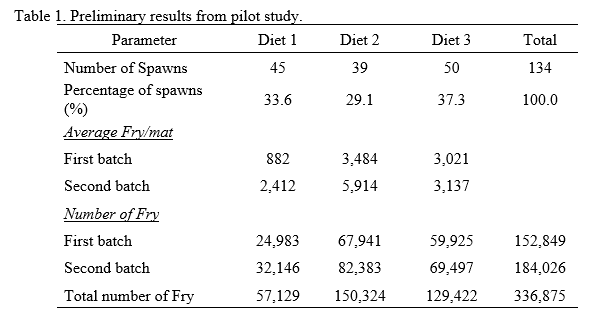PRELIMINARY RESULTS FROM A LARGEMOUTH BASS Micropterus salmoides BROODSTOCK NUTRITION TRIAL
The global aquaculture value and quantity of largemouth bass (LMB) ranked 16 and 19, respectively in freshwater species in 2018, with a total production of 0.458 million tons in 2017, mostly produced in China (Hussein et al. 2020). However, unpredictable, and variable reproductive performance have been indicated as primary bottlenecks for the industry (Hussein et al. 2020). Nutritional status of the brooders is critical for spawning and egg quality since nutrients are transferred from the female to the egg (Migaud et al. 2013; Izquierdo et al. 2015). Aside from essential fatty acids and amino acids, there is potential for other dietary additives such as nucleotides to enhance broodstock nutrition. Nucleotides consist of a purine or a pyrimidine base, a ribose or 2´-deoxyribose sugar and one or more phosphate groups and have essential physiological and biochemical functions related to genetic information, energy metabolism and cell signaling (Li and Gatlin, 2006).
A pilot study to evaluate the impact of essential fatty acids and nucleotides in the LMB spawning performance was set up in a recirculating system composed of three tanks. Each tank was stocked with 100 fish, and fish were fed for 92 days, with three different diets ( Diet 1 - commercial diet, Diet 2 - commercial diet supplemented with fish oil and DHA, and Diet 3 - commercial diet supplemented with a mix of fish oil, DHA and commercial nucleotides). Data collected during this pilot study is presented in the table below. Currently, we are conducting nutritional analysis on the feeds, fish eggs and fry collected for each treatment. While the r esults of this study were not shown to be significantly different, the increased number of fry obtained for each treatment may suggest an effect of the diets in the egg quality. These results are very encouraging for expanding the knowledge of the effect on the nutrition of reproductive performance of the largemouth bass.
